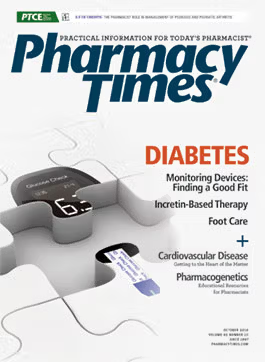Publication
Article
Pharmacy Times
Pancreatic Enzyme Replacement Therapy: A View From Behind the Counter
Author(s):
This article was sponsored by AbbVie, Inc.
Underdosing.1 Noncompliance.2,3 Unclear treatment expectations.4 These are some of the ongoing challenges associated with pancreatic enzyme replacement therapy (PERT) that highlight the clear need for increased pharmacist-to-patient engagement. In this article, we will discuss appropriate medication administration and the role of pharmacists in managing PERT (TABLE 12-7).2,5-7

DIGESTIVE ENZYME SECRETION ORIGINATES IN THE PANCREAS
In healthy adults, normal pancreatic functioning enables the body to properly digest and absorb nutrients.3 The primary role of the pancreas is exocrine function, with 85% of the organ responsible for the secretion of digestive enzymes, water, and bicarbonate into the duodenum.8 The release of enzymes helps people properly digest fats, carbohydrates, and proteins.3,7,9
WHEN EXOCRINE PANCREATIC FUNCTION IS INSUFFICIENT
Exocrine pancreatic insufficiency (EPI) occurs when the pancreatic enzyme activity in the intestinal lumen is reduced below the minimum level needed to maintain normal digestion.7,10 Certain underlying conditions that affect the pancreas are associated with EPI (TABLE 29,11-17).7,9,11,12 Two major effects of EPI include maldigestion of fat and malabsorption of nutrients, such as fat-soluble vitamins, including A, D, E, and K.7,9 Patients with EPI may experience symptoms resulting from undigested fat passing through the gastrointestinal tract.7,9 These symptoms can vary, but may include steatorrhea (bulky, oily, foul-smelling stools), diarrhea, unexplained weight loss, flatulence, bloating, and abdominal pain.3,4,7,9,18
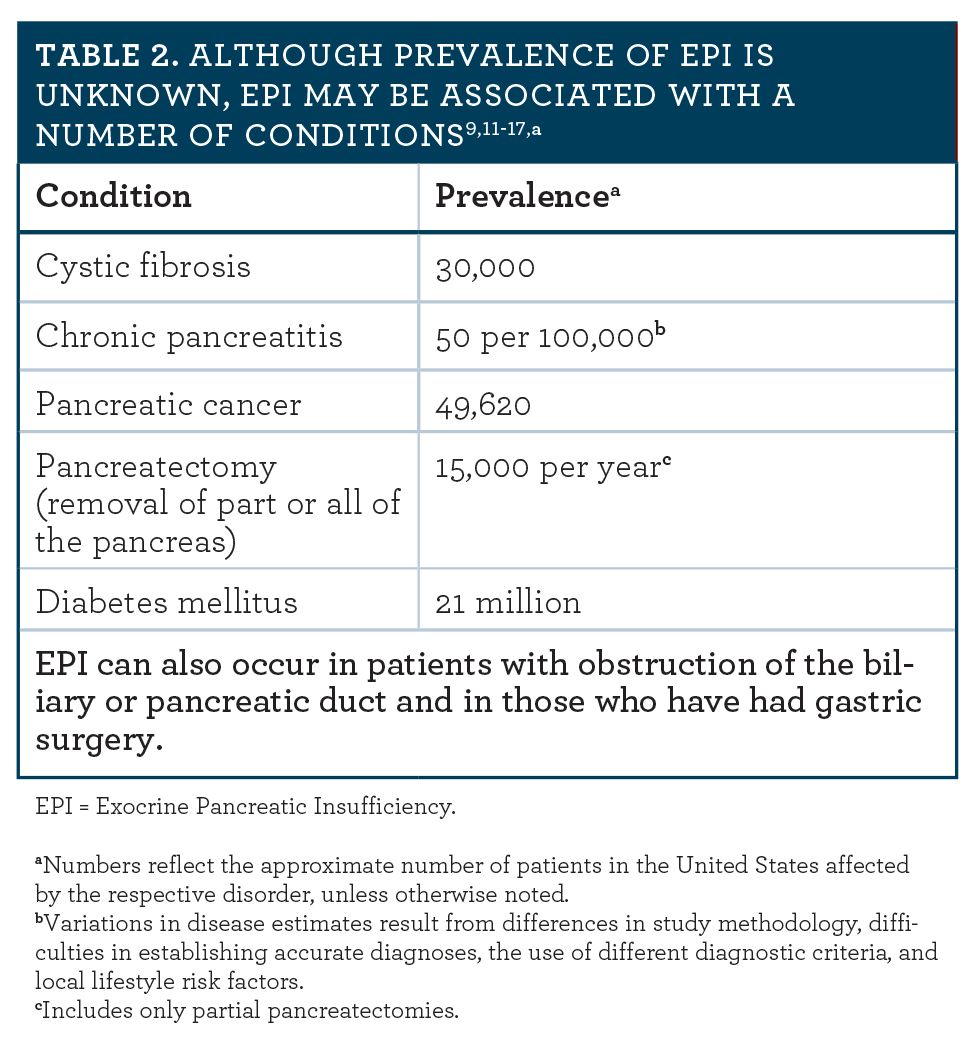
PERT: THE STANDARD OF CARE FOR EPI3
From March 1, 2010, to February 1, 2016, more than 7 million PERT prescriptions were filled in the United States (FIGURE19).19 PERT is prescribed to help mimic the physiological pattern of pancreatic exocrine secretion, delivering enzymes into the duodenum together with food.3 PERT includes 3 types of enzymes: lipases, amylases, and proteases, which help the body break down and absorb fats, carbohydrates, and proteins, respectively.3,20
To be effective in managing EPI, PERT must be taken appropriately to ensure that both enzymes and food reach the duodenum at the same time.3,5,21
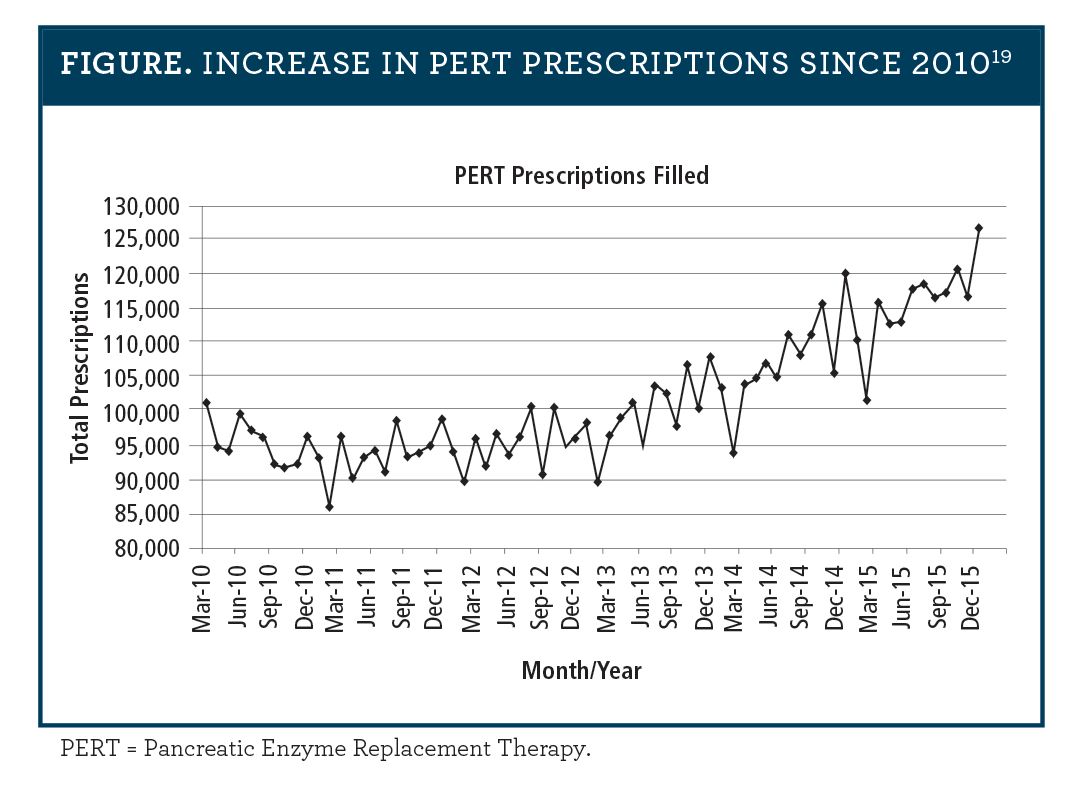
ACCURATE DOSING OF PERT IS ESSENTIAL FOR EPI MANAGEMENT
The prescribed PERT dose should be individualized and adjusted based on weight, fat content of the patient’s diet, degree of steatorrhea, and clinical symptoms.4 These criteria should also be used for titrating patients to the appropriate dose.4
According to the Cystic Fibrosis Foundation (CFF) Consensus Conference Guidelines, weight-based enzyme dosing for patients 4 years or older should begin at 500 lipase units/kg/meal, adjusting to a maximum of 2500 lipase units/kg/meal, if needed (TABLE 35).5 The total daily dose should not exceed 10,000 lipase units/kg.3,5 Using a fat-content-of-the-diet approach, patients will typically need between 500 lipase units and 4000 lipase units per gram of fat ingested per day.4,5,22

The total daily PERT dose should reflect consumption of approximately 3 meals and 2 or 3 snacks per day.4,5,22 Typically, only half the prescribed dose is needed for snacks.5
PERT UNDERDOSING: AN ONGOING PROBLEM
Although PERT has been proven efficacious in the treatment of EPI, nutrient and fat absorption depend on appropriate weight-based dosing.3,4 It is important to continue to assess a patient’s response to therapy to help ensure accurate dosing.5
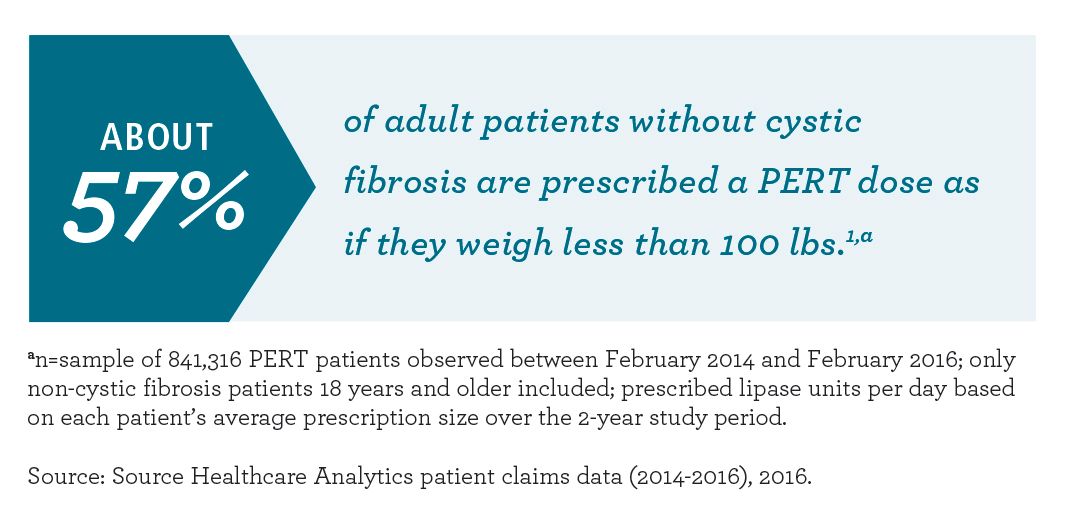
If patients are still experiencing symptoms after PERT initiation, they should be encouraged to have a follow-up visit with their physician.
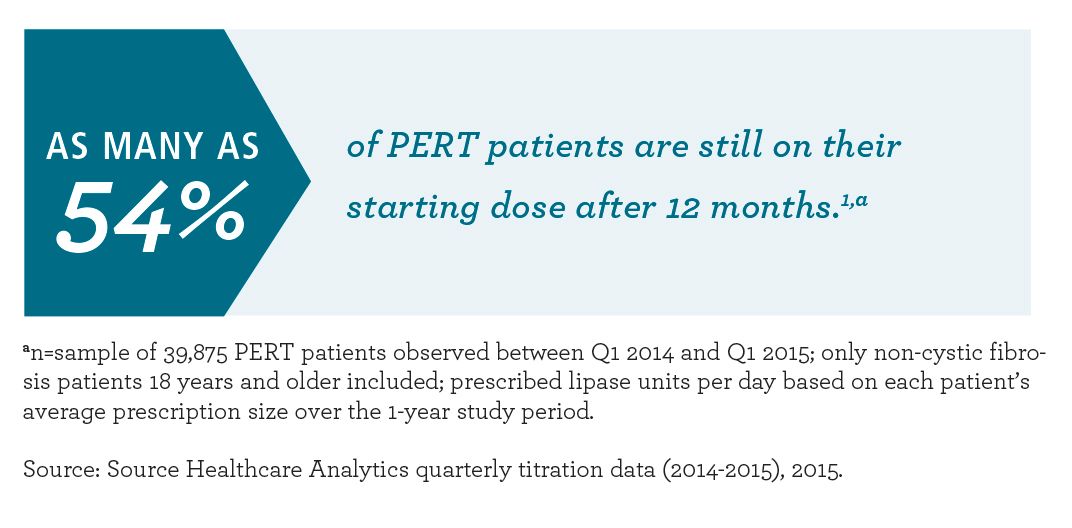
THE REALITY OF PATIENT EXPERIENCE ON PERT
Despite PERT being the standard of care for EPI treatment, a review of prescription data shows that nearly 37% of new PERT patients (not including those with cystic fibrosis) did not refill their prescription.1

The CFF Consensus Conference Guidelines define poor response to therapy as patients continuing to experience abdominal complaints (such as pain, bloating, and flatus), abnormal stool movement (such as loose or frequent stools, overt diarrhea, and symptomatic steatorrhea), and/or poor development in children (caused by malnutrition) despite treatment with PERT.5,6 If patients are experiencing any of these symptoms, there may be possible factors that are causing them to have a poor response to treatment (TABLE 45,9,20,21).5

COUNSELING PATIENTS PRIOR TO PERT USE
Consumption of PERT with food contributes to the effectiveness of managing EPI.9 PERT has been proven to be effective when taken in tandem with high-fat diets compared with low-fat diets.9 Low-fat diets can also be connected to insufficient intake of fat-soluble vitamins.9 Therefore, it is important to note that fat reduction is no longer considered a part of the management plan for EPI due to chronic pancreatitis.9
It is essential that patients understand the importance of taking PERT with milk or snacks that contain fat, at a dose that is typically half of their prescribed dose.5
Here is what patients should know before starting PERT2,5,21:
- PERT should be taken with every meal and snack
- Sporadic doses (not taken with food) should be avoided
- Dosage should not be changed or increased without physician direction
Patients who are prescribed PERT should also consider seeing a dietitian to ensure they are consuming the recommended amounts of fats and calories.10 For example, in patients with cystic fibrosis, the CFF Consensus Conference Guidelines recommend that “patients should consume a high-calorie diet with unrestricted fat which is appropriate for age and clinical status.”5
In addition to PERT, various elements can factor into a patient’s comprehensive EPI management plan.3,9,10 Patients with EPI may be advised to eat a nutritionally well-balanced diet and take vitamin and mineral supplements, including fat-soluble vitamins A, D, E, and K. Smoking cessation and alcohol cessation are also recommended to help manage EPI.3,9,10
ROLE OF THE PHARMACIST
PERT may be an unfamiliar type of treatment for patients; thus, there is an opportunity for pharmacists to play an active role in EPI management. Before dispensing PERT, it is imperative that patients understand both the dosing schedule and what to expect with treatment. Pharmacists should also instruct patients to speak with their physician before discontinuing therapy. Pharmacist-specific goals for patients with EPI should include dose verification, proper expectation setting, appropriate treatment administration, and comprehensive PERT counseling.2,5-7
INITIATING THE PHARMACIST-TO-PATIENT DISCUSSION ABOUT PERT
Many factors can contribute to the success of PERT treatment. Pharmacists should have ongoing communication with patients to ensure they are comfortable taking PERT, understand how it is different from other medications, and have all the knowledge they need throughout their course of treatment.
Here are some questions to help start the discussion with patients:
- How did your doctor tell you to take this medication?
- What did your doctor tell you to expect with treatment?
- Do you have a follow-up appointment already scheduled with your physician?
- Did your doctor talk to you about taking your PERT with snacks?
- Where do you plan to store your medication?
- Are you currently taking any vitamin supplements?
- Do you know what resources are available in case you have questions about your prescription?
- Have you looked into financial assistance for your PERT medication?
Pharmacists can get more information about EPI and PERT from professional organizations (TABLE 5). Additionally, pharmacists can help patients have a more informed discussion with their doctor by referring them to IdentifyEPI.com.
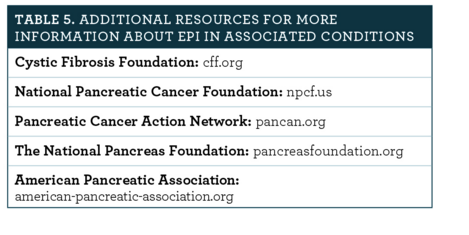
REFERENCES
- Data on file. North Chicago, IL: AbbVie Inc.
- Imrie CW, Connett G, Hall RI, Charnley RM. Expert commentary: how we do it. In: Imrie CW, ed. Review article: enzyme supplementation in cystic fibrosis, chronic pancreatitis, pancreatic and periampullary cancer. Aliment Pharmacol Ther. 2010;32(suppl 1):21-24. doi: 10.1111/j.1365-2036.2010.04437.x.
- Fieker A, Philpott J, Armand M. Enzyme replacement therapy for pancreatic insufficiency: present and future. Clin Exp Gastroenterol. 2011;4:55-73. doi:10.2147/CEG.S17634.
- Hammer HF. Pancreatic exocrine insufficiency: diagnostic evaluation and replacement therapy with pancreatic enzymes. Dig Dis. 2010;28(2):339-343. doi: 10.1159/000319411.
- Borowitz DS, Grand RJ, Durie PR. Use of pancreatic enzyme supplements for patients with cystic fibrosis in the context of fibrosing colonopathy. Cystic Fibrosis Foundation website. http://cff.org/uploadedFiles/Content/For_Caregivers/Clinical_Care_Guidelines/Nutrition_and_GI_Clinical_Care_Guidelines/Consensus-Statement-Pancreatic-Enzyme-Replacement-March-1995.pdf. Published March 1995. Accessed January 28, 2016.
- Connett G. Case study 1: cystic fibrosis and the pancreas — pancreatic enzyme supplementation for improved outcomes. In: Imrie CW, ed. Review article: enzyme supplementation in cystic fibrosis, chronic pancreatitis, pancreatic and periampullary cancer. Aliment Pharmacol Ther. 2010;32(suppl 1):6-11. doi:10.1111/j.1365-2036.2010.04437.x.
- Ferrone M, Raimondo M, Scolapio JS. Pancreatic enzyme pharmacotherapy. Pharmacotherapy. 2007;27(6):910-920.
- Gorelick FS, Jamieson JD. Structure—function relations in the pancreatic acinar cell. In: Johnson LR, ed. Physiology of the Gastrointestinal Tract. 4th ed. Burlington, MA: Elsevier Academic Press; 2006:1313-1335.
- Domínguez-Muñoz JE. Pancreatic enzyme therapy for pancreatic exocrine insufficiency. Curr Gastroenterol Rep. 2007;9(2):116-122.
- Lindkvist B. Diagnosis and treatment of pancreatic exocrine insufficiency. World J Gastroenterol. 2013;19(42):7258-7266. doi: 10.3748/wjg.v19.i42.7258.
- Keller J, Layer P. Human pancreatic exocrine response to nutrients in health and disease. Gut. 2005;54(suppl 6):vi1-vi28.
- Expert Committee on the Diagnosis and Classification of Diabetes Mellitus. Report of the Expert Committee on the Diagnosis and Classification of Diabetes Mellitus. Diabetes Care. 2003;26(suppl 1):S5-S20.
- About cystic fibrosis. Cystic Fibrosis Foundation website. http://cff.org/AboutCF. Accessed February 1, 2016.
- Yadav D, Lowenfels AB. The epidemiology of pancreatitis and pancreatic cancer. Gastroenterology. 2013;144(6):1252-1261. doi: 10.1053/j.gastro.2013.01.068.
- SEER Cancer Statistics Review, 1975-2013: Table 22.21. Cancer of the pancreas (invasive). National Cancer Institute website. http://seer.cancer.gov/csr/1975_2013/results_merged/sect_22_pancreas.pdf. Accessed June 14, 2016.
- National Center for Health Statistics. National Hospital Discharge Survey, 2010. Hyattsville, Maryland. Public Health Service, 2010.
- 2014 National Diabetes Statistics Report. Centers for Disease Control and Prevention website. http://cdc.gov/diabetes/data/statistics/2014statisticsreport.html. Updated May 15, 2015. Accessed February 1, 2016.
- Borowitz D, Durie PR, Clarke LL, et al. Gastrointestinal outcomes and confounders in cystic fibrosis. J Pediatr Gastroenterol Nutr. 2005;41(3):273-285.
- IMS Health. IMS National Prescription Audit. February 2016.
- Trang T, Chan J, Graham DY. Pancreatic enzyme replacement therapy for pancreatic exocrine insufficiency in the 21st century. World J Gastroenterol. 2014;20(33):11467-11485. doi: 10.3748/wjg.v20.i33.11467.
- Sikkens EC, Cahen DL, van Eijck C, Kuipers EJ, Bruno MJ. The daily practice of pancreatic enzyme replacement therapy after pancreatic surgery: a northern European survey: enzyme replacement after surgery. J Gastrointest Surg. 2012;16(8):1487-1492. doi: 10.1007/s11605-012-1927-1.
- Domínguez-Muñoz JE. Pancreatic enzyme replacement therapy for pancreatic exocrine insufficiency: when is it indicated, what is the goal and how to do it? Adv Med Sci. 2011;56(1):1-5. doi: 10.2478/v10039-011-0005-3.
853-1869865
